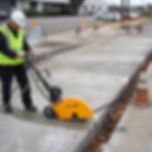
Crystalline silica can be commonly found in naturally occurring materials. Many common used materials such as sand, stone, and concrete are accessible in many places. For industrial use, crystalline silica are found in products of glass, ceramics, and pottery.
Respirable crystalline silica can be created through cutting, sanding, drilling, and fracking. Once the respirable crystalline silica enters our body, the chronic effect is irreversible. Inhaling silica is believed to cause:
Silicosis
Lung Cancer
Damage to Kidneys
After 45 years, Occupational Safety & Health Administration (OSHA) has finally updated the silica rule with two new standards: General Industry & Maritime and Construction
General Industry & Maritime
OSHA estimates that over 100,000 workers will expose to silica that exceed the new permissible exposure limit (PEL) in general industry and maritime sectors. There are several key requirements added to the new standard:
Measure workers' exposure to silica if the action level may be at or above 25 µg/m3 average over an 8-hour day;
Protect workers' exposure to silica if the PEL is above 50 µg/m3 average over an 8-hour day;
Limit access to areas that may expose workers to silica and housekeeping methods with alternatives if feasible;
Provide dust control methods to workers;
Develop written exposure control plan that identifies tasks at risk;
Supply respirators for workers exposed above the PEL;
Offer medical exams (chest X-ray and lung capacity test) for workers exposed to at or above the action level for 30 days or more year.
Construction
OSHA estimates that over 840,000 workers will expose to silica that exceed the new PEL in construction sectors. The key requirements are similar to general industry and maritime, however, OSHA provides employers to either choose alternative methods in Table 1 or measure exposures on silica.

For example, if a worker is cutting the silica-containing concrete base using a walk-behind saw, it must be equipped with the water delivering system that continuously feeds the water. In this case, the worker does not need a respirator when performing the work outdoors less or more than 4 hours per day. A respirator with at least an assigned protection factor (APF) of 10 is required when the work is performed indoors or in an enclosed area for both less or more than 4 hours per day.

Compliance Calendar
Employers in different sectors are required to comply with the new standard by:
General Industry & Maritime - June 23, 2018
Medical Surveillance - June 23, 2020 (exposure at or above the action level for 30 or more days per year); June 23, 2018 (exposure above the PEL for 30 or more days per year)
Hydraulic Fracturing - June 23, 2021 (implement engineering controls)
Construction - June 23, 2017
Laboratory Evaluation - June 23, 2018
Additional Information
United EHS Consulting provides professional consultation services to all levels of employers. The author/consultant has several years of experiences in exposure assessment, program management, and injury prevention. For any inquiries, contact us through our website.
